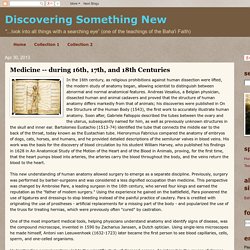

Kids Work! > History of Medicine. Medical research and training improved in the 18th century but there were still no cures for diseases like smallpox, a disease that killed millions of people over thousands of years.

Middle Eastern doctors gave people mild doses of the smallpox to combat the disease. Some patients became immune, but many died or spread the disease to more people. British Doctor Edward Jenner (1749-1823), noticed that milkmaids who got the cowpox disease from cows did not get smallpox. He developed a vaccination with the fluid from the cowpox sore that protected people from the deadly disease.
In the early 19th Century, doctors used ether to put patients to sleep during surgery. Although women were known as healers for centuries, they were not allowed to attend medical school. On the battlefield, she was known as “Mother Seacole.” Surgeons and Butchers. The views held by 18th century physicians are very different from those held by medical practitioners of today.

Physicians in the 18th century had no knowledge of bacteria, germs, or viruses, nor of the fact that disease was spread by them. Therefore, they did not practice sterilization, or personal or hospital hygiene. In 350 B.C. Aristotle believed that everything — all matter — was made from earth, air, fire, or water. In his view, and in the view of the Greek physician Galen, who practiced five hundred years after Aristotle, these four elements explained illness and disease.
Medical practitioners of the colonial period in America most commonly held the theories of Hermann Boerhaave (1668-1738). Important scientists during this time period such as Sir Isaac Newton, Robert Boyule, Galileo Galilei, and William Harvey were rewriting the laws of nature. There were approximately 3,500 practicing physicians in the colonies in 1775. Most wounds were caused by musket balls or the bayonet. Funeral Customs. Funerary Practices. Funerary Practices in Early and Modern America Loretta M.

Alirangues The early American colonists believed that “the grave was familiar as the cradle,” and accepted death as natural and inevitable. In Dutch New Amsterdam, “inviters” were hired to go door to door to inform friends and relatives that a loved one had passed on, and to invite them to the funeral. In Pennsylvania, these people were called “warners.” Southern funerals were major social events in the nineteenth century.
In the early to mid-nineteenth century, coffins were usually made of poplar, mahogany, walnut or cherry. In the earliest colonial days, a body was carried to its final resting place on a frame of planks. Receptions were held after a burial in the home of the deceased, and often they became very spirited parties. Mourning etiquette was not given much consideration by the early colonists, but with the Victorian era came many customs. Medical Procedures and Medications. Medical Procedures Table of Contents: This page describes various medical procedures, treatments, and medications commonly practiced and used in the past and present. Although several treated physical symptoms, the practices on this page are relevant as treatments for mental disorders.
William Smellie was the first obstetrician to scientifically study the process of child birth. He published the (1752-64). He gave numerous lectures to midwives and students on childbirth techniques in London. Source: Porter, Roy. Return to Top Also known as , refers to anything applied to raise a blister or vesicle on the skin. {*style:<u><b>Bloodletting </b></u>*} The procedure of withdrawing blood from a patient's vein for therapeutic purposes.
“Woodward, John (1665-1728).” . In its various forms, confinement was used to treat madness as much as any medication in the eighteenth century. Sources: Patterns of Madness: William Battie, Samuel Tuke Return to Top. HISTORY OF MEDICINE. Discovering Something New : Medicine. In the 16th century, as religious prohibitions against human dissection were lifted, the modern study of anatomy began, allowing scientist to distinguish between abnormal and normal anatomical features.

Andreas Vesalius, a Belgian physician, dissected human and animal cadavers and proved that the structure of human anatomy differs markedly from that of animals; his discoveries were published in On the Structure of the Human Body (1543), the first work to accurately illustrate human anatomy.